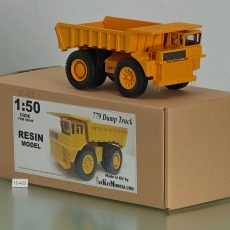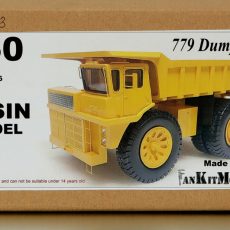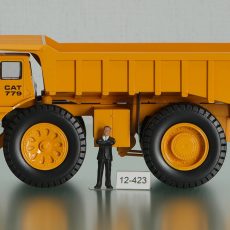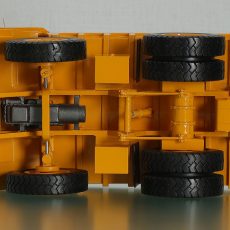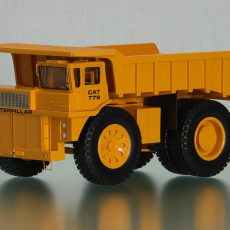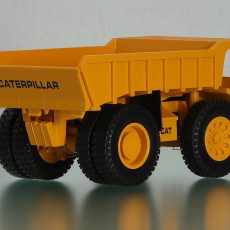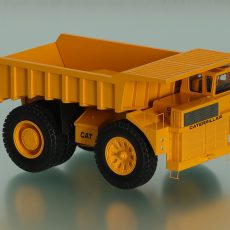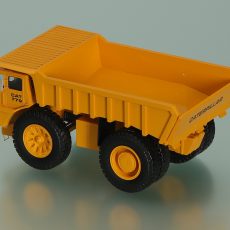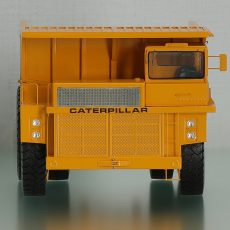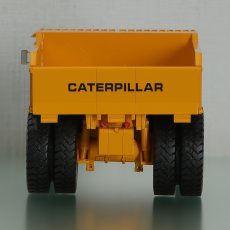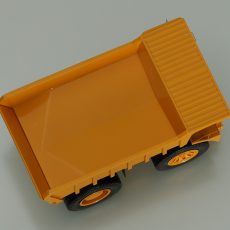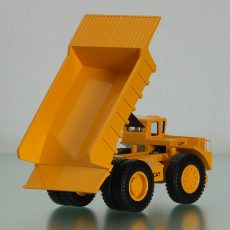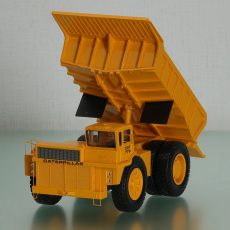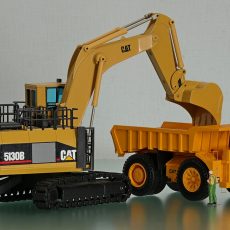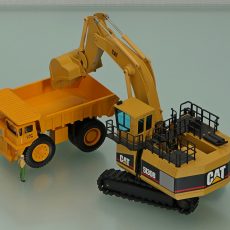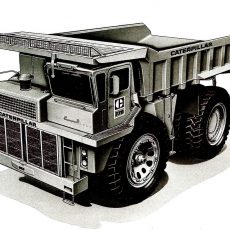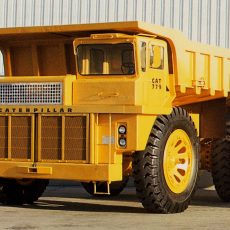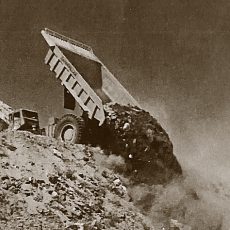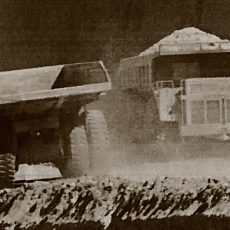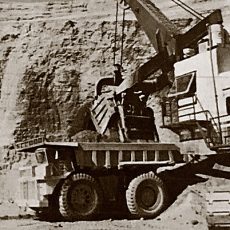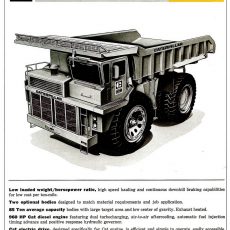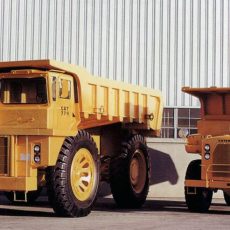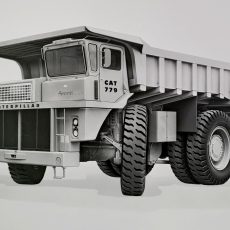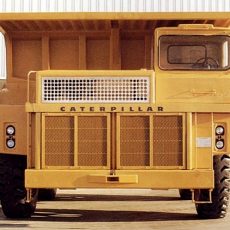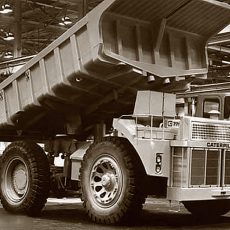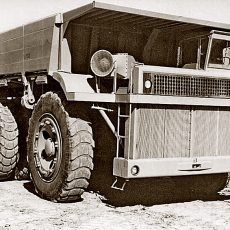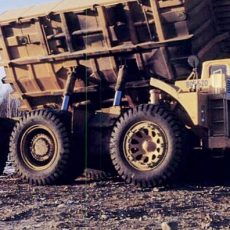Caterpillar 779 Mining dump Truck
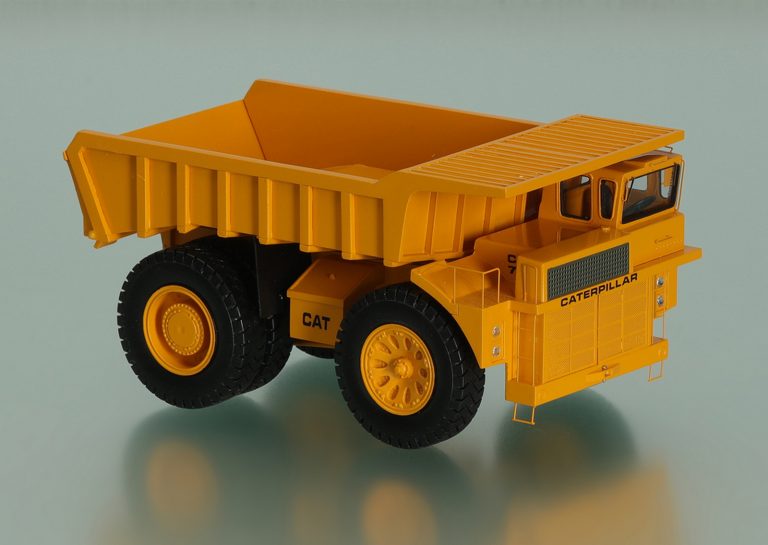
Caterpillar 779 4х2 карьерный внедорожный самосвал задней выгрузки гп 67.5/76.5 тн с электрической трансмиссией, ёмк. кузова 42 м3, снаряжённый вес 54 тн, полный вес 131.5 тн, Cat D348 960 лс, 59.5 км/час, 41 экз., США 1965-69 г. в.
Caterpillar 779 4х2 Mining dump Truck, back discharge, load capacity 67.5/76.5 tons, capacity bodywork 42 m3, curb weight 54 tons, total weight 131.5 tons, maximum speed 59.5 km/h.
Engine: Cat D348 960 HP
41 pieces, Manufactured in the USA in 1965-69.
Описание оригинала
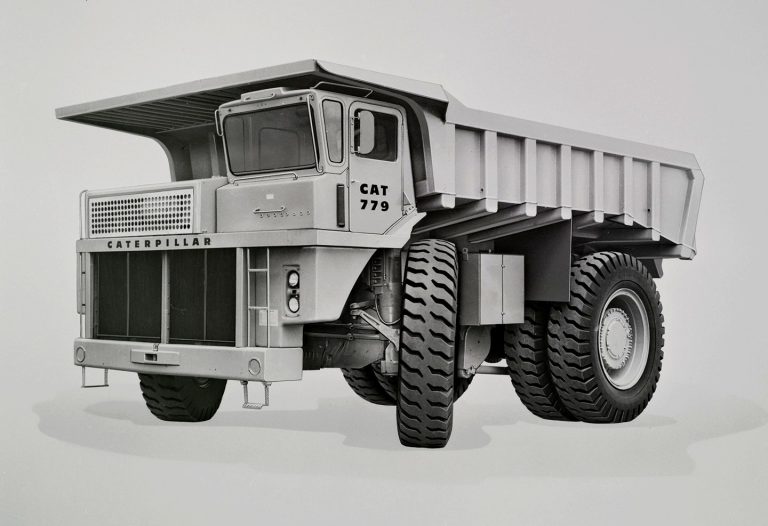
Начало выпуска:
Окончание выпуска:
Файлы
779: left 75Ton, прототип электропривода, представленный в 1964 году и выпущенный на рынок в 1967 году.
После проведения обширных маркетинговых исследований в 1965 году компания CAT представила прототип 779, ранний электротранспортный карьер CAT, который в конце 1965 года начал пробную эксплуатацию на шахте в Мичигане. В 779 используется двигатель CAT D348 с электрической трансмиссией, разработанный и изготовленный самой компанией CAT. изначально 779 имел грузоподъемность 75 коротких тонн и был модернизирован до 85 коротких тонн в 1968 году. Первоначально выпущенный 779 имел множество конструктивных недостатков, но, несмотря на последующие улучшения, его рама, электроприводы и система подвески оставались неисправными, и в конце концов CAT прекратил производство 779 в мае 1969 года, когда было выпущено 41 модель, и чтобы сократить расходы на последующее обслуживание, CAT выкупил все проданные 779 и полностью снес их. Для CAT 779 была неудачной моделью, что привело к тому, что CAT в течение последующих 40 лет не испытывал чувства к электрическому приводу и продолжал идти по пути механической передачи.
Основные технические данные:
Год выпуска: 1966 Чистая мощность: 974 л. с. Грузоподъемность: 85 коротких тон
Sales Model -779, Engineering Model - RM233 раб.вес 53.9 тн
Engine - D348 @ 2000 RPM and 960 Horsepower, Electric Drive, 85 Ton load capacity
Start of productin date - 10 November 1966,
Start serial number - 45H40 Stop serial number - 45H80
End of production date - 23 May 1969
Total production - 41 units
По большому историческому интересу, начальником отдела проектирования и производства самосвалов в этот момент как раз оказался некто Ральф Х. Кресс .. бывший менеджер по развитию грузовик в городе Ле-Турно-Вестингауз, и конструктор первых Haulpak грузовиков.
Кресс был объявлен в розыск и получил должность менеджера по развитию грузовых автомобилей в научно-техническом отделе компании Caterpillar. Значительная способность и влияние Кресса были очевидны, когда руководство Cat начало исследование более крупных моделей грузовиков и решило использовать дизель-электрический привод, модель 75 тонн, в качестве следующего продукта после 769.
Этот грузовик, известный как 779, был произведен в качестве прототипа в 1965 году .. наряду с двумя другими моделями дизель-электрического привода, 783 и 786. Прототип 779 был доставлен в Cleveland Cliffs Iron Co, Republic mine, в Маркетт, штат Мичиган в конце 1965 года для изнурительных испытаний на месте. В октябре 1966 года руководство Cat дало добро на полное производство 779.
Ранняя серийная модель 779-х годов была полна серьезных конструктивных недостатков. Шасси в 779 использовало высокую растяжимую сталь, тогда как 769 использовало слабую сталь. Шасси 779 было склонно к растрескиванию в течение короткого количества часов работы. Ремонт специальной высокопрочной стали в шахтных условиях был затруднен, и ремонт, как правило, был неудовлетворительным.
Cat быстро переработал шасси, добавив намного больше стали, и улучшенная конструкция была официально выпущена для публичной продажи в июле 1967 года.
Первоначально 75-тонная конструкция, грузоподъемность была увеличена до 85 тонн в 1968 году после дальнейших улучшений конструкции.
779-й был катастрофой. Рама все равно треснула, даже после редизайна, электропривод был постоянным источником проблем .. и очень сложная (читай, сложная) пневмомасляная подвеска тоже была полна проблем.
Наконец, Кэт было достаточно. В мае 1969 года производство 779 было прекращено, после того, как в общей сложности было построено 41 779. Чтобы устранить дальнейшие гарантийные претензии и затраты на Cat, все 41 грузовик был выкуплен Cat и уничтожен путем демонтажа. Ни один 779 не выживает.
Это, должно быть, было очень дорогим упражнением для кошки, и, очевидно, превратило управление кошкой против электрического привода почти на 4 десятилетия. Кэт вернулась к механическому приводу и рекламировала его как менее дорогостоящую и простую в обслуживании систему в течение почти следующих 40 лет .. с практически каждой брошюрой Cat truck в тот период, насмехаясь над стоимостью и сложностью электрического привода .. в любой форме.
Интересно, что за последние 10 лет Cat неохотно признал, что электрический привод действительно имеет много преимуществ, если он правильно спроектирован .. особенно в больших машинах. Новый электропривод D7E является одним из новой линейки кошек, что, безусловно, будет означать, что гораздо больше кошек в будущем будут похвастаться электрическим приводом.
Дон, я не могу помочь тебе с идентификацией твоего таинственного грузовика .. но, возможно, 779 был моделью, которую вы помните, поскольку это был один из крупнейших самосвалов Cat, произведенных в 1960-х годах, и это была модель, которая действительно видела производство. В ту эпоху были и другие экспериментальные проекты грузовиков Cat haul, но, похоже, мало кто покинул испытательные полигоны Cat, и многие из них были одноразовыми.
THE STORY BEHIND THIS MODEL
"It was in the mid -1950's when Caterpillar, in East Peoria, Ill., launched its efforts for the design of a family of off-high-way trucks (OHT). While the work started in the mid-1950's, the first model the 769, with a 35-ton payload, was not ready for production until January 1963, about eight years later and after several hand-built concepts had been tested and rejected.
The long delay to first production was due to the fact that many middle and senior level company managers did not want to be involved with the design of a new product line that had an uncertain future. They were traditional Caterpillar men, whose positions in the company were a result of many years of earning their stripes in a firm where experience was the prerequisite to advancement. They were talented men, capable and comfortable making decisions for the "meat and potatoes" products for which CAT was the recognized worldwide leader. But they had little time for the added burden of this stepchild. The new off-highway-truck design group was not given needed direction and support by the company.
Some members of the board of directors recognized that there was a tremendous future in the off-highway-truck business, and that CAT was losing out to others who were making the most of those opportunities. They recognized that trucks were the obvious trend in the mining and construction business, and they were frustrated at the slow pace of progress being made at their company. As time went on, they became very vocal about getting the show on the road, and they were putting pressure on the top administrative officers to that end.
In 1961, the year of "the great electrical conspiracy," a price-fixing and bid-rigging fiasco, a number of high-level executives lost their jobs at General Electric and became available for top jobs elsewhere. One of those executives was hired by Wabco, Westinghouse Air Brake Company (formerly the R. G. LeTourneau Company), Caterpillar's neighbor across the Illinois River in Peoria. A number of associates came along with that executive, crowding the upper-level managers at Wabco.
Shortly thereafter, CAT hired the former president of Wabco, and he brought along a solution to the problem of the slow pace of development of the OHT program at his new place of business. As a result, the then president of Caterpillar hired a man from Wabco, who brought along several other engineers, whose group was developing that company's line of off-highway-trucks. Since he was hired by the president of Caterpillar, the new man had full rein to run things his way with little interference by other high-level CAT managers, including those in Engineering and the Test and Evaluation Divisions. His assignment was to develop and OHT in the 75-ton capacity range and to include the latest technology. Its model designation was to be the Model 779.
His philosophy was to build the machine as light as possible (to increase the payload to tare weight ratio), and if Proving Ground and field test experience exposed shortcomings, to work with customers on their job sites to try out the necessary changes and corrections. This approach was common among smaller competitors, were often the first hand-built machine had to be sold to keep the company solvent. Customer expectations of the ruggedness and availability for CAT machines are often higher than the competition. But in the case of the 779, testing was not rigorous enough o meet those durability requirements. Nothing was allowed to retard the program schedule.
At that time, the culture at CAT was that, while it was often not the first to be in production with a new family of vehicles, it proved the worthiness of its machines in its own backyard before selling them, with extended testing and with fixed in place before releasing to production. CAT aimed for having the world's best machines, and as much as possible, proven and ready for the marketplace with excellent availability and supported by unsurpassed service. This approach usually resulted in market dominance after a few years of production. Initial vehicle costs were often higher than others, but over the long haul, the CAT machines put a lot more money in the customer's pocket than did those of the competition. That demands a well-organized system of independent check and balances to achieve the best product. The difference in culture began to show.
The new machine had a CAT designed electric power transmission system, including a generator attached to the rear of the Diesel engine, traction motors located inside the rear axle housing, and the switching gear and component cooling systems. It was intended to challenge what General Electric was selling to the competition. The 779 used the D348 engine, running at 2,000 RPM, set at 960 horsepower and the vehicle had a rated payload capacity of 75 tons. Production started on November 10, 1966 with serial No. 45H40 and continued until May 23, 1969 with Serial No. 45H80. Total production was 41 units. The company provided total vehicle support to the customers, including both parts and manpower. The customer was essentially risk-free in this situation, and unless failures caused a loss of production, he was in a very good position.
After about 2-1/2 years, production was stopped. Major problems with the electric traction system, the main frame and with other high-cost areas resulted in a deteriorating reputation for the vehicle and the inevitable loss of interest by the marketplace. Also, the company could not see light at the end of the tunnel were warranty costs were out of control.
Sometime later all of the machines that had been shipped to the field were cut up with torches and large expense was incurred in scrapping tooling and new material in the supply pipeline.
Meanwhile, the 773 OHT had been designed and introduced at the Decatur plant by the local engineering group. It was a 50-ton capacity mechanical drive machine and fell into a size class between the 769 and the 779.
Then in May of 1975, the first production 777 OHT was built in Decatur after it had been designed by the engineers at that plant. Also a mechanical drive truck, it was one of the most successful Off-Highway-Trucks ever introduced, with excellent acceptance around the world. It was reliable and tough, it had great design balance and with its good availability, it made a lot of money for a lot of people. Thousands of these machines were built, and updated versions of this model continue in production at Decatur to this day (written in 2002).
The design of the very successful 777 machine profited from the experience gained, both the successes and the failures of the 779 vehicles. Then too, many internal controls were put in place and strictly adhered to, after the 779 experience, to monitor and review the development and introduction of all new CAT products. These contributions turned out to be the best legacy of the 779 program."
Well, what an interesting history of CAT's first production Off-Highway-Truck !! Now on to some more of my observations of some of the special details on this truly exceptional huge model truck.

